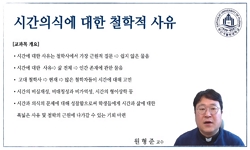본 연구는 인지언어학적 관점에서 요한 복음서에 나타나는 시간 관련 표현들을 분석함으로써, 요한 복음서의 시간 인지 모형이 지니는 특징을 밝히는 연구다. 인지언어학적 관점에서 보면, ...
http://chineseinput.net/에서 pinyin(병음)방식으로 중국어를 변환할 수 있습니다.
변환된 중국어를 복사하여 사용하시면 됩니다.
- 中文 을 입력하시려면 zhongwen을 입력하시고 space를누르시면됩니다.
- 北京 을 입력하시려면 beijing을 입력하시고 space를 누르시면 됩니다.
https://www.riss.kr/link?id=A101958489
-
저자
염철호 (부산가톨릭대학교)

- 발행기관
- 학술지명
- 권호사항
-
발행연도
2016
-
작성언어
-
-
주제어
요한 복음서 ; 시간 ; 시간 인지 모형 ; 예수의 때 ; 시간 은유 ; 영원 ; John’s Gospel ; Time ; Time Cognitive Model ; The Time of Jesus ; Time Metaphor ; Eternity
-
KDC
230
-
등재정보
KCI등재
-
자료형태
학술저널
-
수록면
161-188(28쪽)
-
KCI 피인용횟수
0
-
비고
학회 요청에 의해 무료로 제공
- DOI식별코드
- 제공처
-
0
상세조회 -
0
다운로드
부가정보
국문 초록 (Abstract)
본 연구는 인지언어학적 관점에서 요한 복음서에 나타나는 시간 관련 표현들을 분석함으로써, 요한 복음서의 시간 인지 모형이 지니는 특징을 밝히는 연구다. 인지언어학적 관점에서 보면, 모든 언어는 시간을 움직이는 개체로 은유적으로 개념화하는 특성이 있다. 곧, “마감 시간이 지났다”, “크리스마스가 다가온다” 등에서 볼 수 있듯이 ‘시간’ 관련 개념인 ‘마감시간’과 ‘크리스마스’는 ‘자아’를 지나가거나(과거), 다가오는 것(미래)으로 은유적으로 개념화된다는 것이다. 이때 과거는 자아 ‘뒤’로 이동하는 것으로, 미래는 자아 ‘앞’에 위치해서 자아에게 다가오는 것으로, 현재는 자아와 동일한 위치에 있는 것으로 개념화된다. 이런 시간 관련 은유는 인간이 시간을 인지하는 인지 모형과 관련되어 있는데, 요한 복음서에 나오는 시간 인지 모형들을 조사한 결과 요한 복음서만이 지니는 특이점을 발견할수 있었다. 곧, 시간이 자아를 지나 과거화 되는 표현이 발견되지 않는다는 것이다. 특히 요한 복음서에서 중심이 되는 시간인 예수의 시간, 곧 예수의 때인 경우 그때를 지나는 시간 표현은 나타나지 않는다. 이 점은 요한 복음서의 신학에서 대단히 중요하다. 왜냐하면 요한 복음서는 세상의 모든 시간이 예수의 때, 곧 예수의 죽음과 부활로 완성된다고 여기기 때문이다.
세상의 시간은 예수의 죽음과 부활 사건 이후에도 계속 이어진다. 또한, 하느님의 시간은 시작과 마침도 없이 영원에서 영원까지 지속되는 선적시간(linear time)으로 개념화된다. 하지만 영원에서 시작하여 영원으로 나아가는 하느님의 시간은 예수의 시간 안에서 완성되고 그 시간을 중심으로 하기 때문에 세상의 어떤 시간도 예수의 시간 앞에 위치하여 그 시간을 과거화할 수 없다. 예수의 시간은 영원 안에서만 비로소 이해되고 완성될 수 있는 시간이기 때문이다.
여기서 요한 복음서에 나타나는 또 다른 시간 표현에 대한 설명도 가능해진다. 요한 복음서에는 두 가지 다른 층위의 시간 순서 모형을 기반으로 하는 시간 관련 표현이 나오는데, 바로 요한이 자신 뒤에 오는 예수가 자신 앞에 있던 분이라고 말하는 대목이다(요한 1,15). 이 구절에서 예수는 시간적으로 요한 뒤에 위치하면서, 동시에 앞에 위치한 존재로 개념화된다. 이 역설적인 표현은 예수가 지상의 시간 안에서는 요한에 이어서 등장한 인물이지만 하느님의 시간 안에서는 요한에 앞서 위치한 존재라는 말이다.
다국어 초록 (Multilingual Abstract)
This study analyzes time expressions of John’s gospel, based on the cognitive linguistics and it reveals characteristics of time conceptual models in the fourth gospel. In general, time is conceptualized and expressed metaphorically as a moving obje...
This study analyzes time expressions of John’s gospel, based on the cognitive linguistics and it reveals characteristics of time conceptual models in the fourth gospel. In general, time is conceptualized and expressed metaphorically as a moving object like following sentences, “The deadline has passed”, “Christmas is getting closer.” The time expressions, which are “the deadline” and “Christmas” are metaphorically conceptualized either as an object to pass the ego who stays at the present or an object to come near the ego. The past is conceptualized as an object which is behind the ego and the future as an object which is in front of him. However, in the fourth gospel, no example that there is a time which is conceptualized as an object which is behind of the ego is found. Especially, the time of Jesus, which is a center of the whold divine time in John’s gospel, has never been passed by any earthly time. It is very important in john’s theology, because all times are regarded to be understood and fulfilled in the time of Jesus.
Of course, the earthly time does not cease after the death. And the divine time is conceptualized as a linear time which has neither its beginning nor its end and continues from eternity into eternity. However, this divine time is completed the time of Jesus, which is the center of the divine time. So, any earthly time could not pass the time of Jesus. It is understood and completed only in eternity.
From this, it is possible to understand a paradoxical time expression, which is based on two different types of temporal sequence model: John who proceeds Jesus actually follows him(John 1,15). Jesus follows John in the earthly time, but proceeds him in the divine time.27)
목차 (Table of Contents)
- Ⅰ. 서론
- Ⅱ. 요한 복음서의 자아 토대 모형
- Ⅲ. 요한 복음서의 시간 토대 모형
- Ⅳ. 시간 인지 모형에 대한 신학적 해석
- Ⅴ. 결론
- Ⅰ. 서론
- Ⅱ. 요한 복음서의 자아 토대 모형
- Ⅲ. 요한 복음서의 시간 토대 모형
- Ⅳ. 시간 인지 모형에 대한 신학적 해석
- Ⅴ. 결론
- 참고문헌
- 국문요약
- Abstract
참고문헌 (Reference)
1 염철호, "영어 전치사 on과 이탈리아어 전치사 su의 인지언어학적 고찰" 언어과학회 (61) : 117-142, 2012
2 염철호, "시간 인지 모형에 대한 비판적 고찰" 언어과학회 (64) : 249-268, 2013
3 하성수, "그리스어 문법" 분도 2005
4 Lakoff, G, "Women, Fire and Dangerous Things: What Categories Reveal about the Mind" Chicago University Press 1987
5 Schneider, J., "Theological Dictionary of the New Testament 2" Eerdmans 926-927, 1964
6 Preisker, H., "Theological Dictionary of the New Testament 2" Eerdmans 330-332,
7 Evans, V., "The Structure of Time: Language, Meaning and Temporal Cognition" John Benjamins 2004
8 Tyler, A., "The Semantics of English Prepositions: Embodied Meanin g, and Cognition" Cambridge University 2003
9 Johnson, M., "The Body in the Mind: The Bodily Basis of Meaning, Imagination and Reason" Chicago University Press 1987
10 Lakoff, G., "Philosophy in the Flesh: The Embodied Mind and its Challenge to Western Thought" Basic Books 1999
1 염철호, "영어 전치사 on과 이탈리아어 전치사 su의 인지언어학적 고찰" 언어과학회 (61) : 117-142, 2012
2 염철호, "시간 인지 모형에 대한 비판적 고찰" 언어과학회 (64) : 249-268, 2013
3 하성수, "그리스어 문법" 분도 2005
4 Lakoff, G, "Women, Fire and Dangerous Things: What Categories Reveal about the Mind" Chicago University Press 1987
5 Schneider, J., "Theological Dictionary of the New Testament 2" Eerdmans 926-927, 1964
6 Preisker, H., "Theological Dictionary of the New Testament 2" Eerdmans 330-332,
7 Evans, V., "The Structure of Time: Language, Meaning and Temporal Cognition" John Benjamins 2004
8 Tyler, A., "The Semantics of English Prepositions: Embodied Meanin g, and Cognition" Cambridge University 2003
9 Johnson, M., "The Body in the Mind: The Bodily Basis of Meaning, Imagination and Reason" Chicago University Press 1987
10 Lakoff, G., "Philosophy in the Flesh: The Embodied Mind and its Challenge to Western Thought" Basic Books 1999
11 Langacker, R., "Foundations of Cognitive Grammar vol. I" Stanford University Press 1987
12 Evans, V, "Cognitive Linguistics: An Introduction" Lawrence Erlbaum Associates 2006
13 Cullman, O., "Christ et le Temps" Delachaux & Niestlé 1957
14 Smith, J., "Biblical Greek" Editrice Pontificio Istituto Bi blico 2001
15 Ungerer, F., "An Introduction to Cognitive Linguistics" Pearson 2006
16 Danker, F., "A Greek-English Loxicon of the New Testament and other Early Christian Literature" The University of Chicago Press 422-, 2003
17 Blass, F., "A Greek Grammar of the New Testament and Other Early Christian Literature" University of Chicago Press 1961
동일학술지(권/호) 다른 논문
-
- 한국가톨릭신학학회
- 강은희
- 2016
- KCI등재
-
다석 유영모 신학 사상의 토착화 가능성 연구: 예수의 ABBA 체험의 맥락에서
- 한국가톨릭신학학회
- 황경훈
- 2016
- KCI등재
-
- 한국가톨릭신학학회
- 안봉환
- 2016
- KCI등재
-
그리스도교의 희망과 출애굽 공동체에 대한 이해 - 위르겐 몰트만의 “희망의 신학”을 중심으로 -
- 한국가톨릭신학학회
- 서한석
- 2016
- KCI등재
분석정보
인용정보 인용지수 설명보기
학술지 이력
| 연월일 | 이력구분 | 이력상세 | 등재구분 |
|---|---|---|---|
| 2026 | 평가예정 | 재인증평가 신청대상 (재인증) | |
| 2020-01-01 | 평가 | 등재학술지 유지 (재인증) |  |
| 2017-01-01 | 평가 | 등재학술지 유지 (계속평가) |  |
| 2015-10-23 | 학술지명변경 | 외국어명 : 미등록 -> The Catholic Theology |  |
| 2013-01-01 | 평가 | 등재 1차 FAIL (등재유지) |  |
| 2010-01-01 | 평가 | 등재학술지 선정 (등재후보2차) |  |
| 2009-01-01 | 평가 | 등재후보 1차 PASS (등재후보1차) |  |
| 2007-06-28 | 학회명변경 | 영문명 : 미등록 -> CATHOLIC THEOLOGICAL ASSOCIATION OF KOREA |  |
| 2007-01-01 | 평가 | 등재후보학술지 선정 (신규평가) |  |
학술지 인용정보
| 기준연도 | WOS-KCI 통합IF(2년) | KCIF(2년) | KCIF(3년) |
|---|---|---|---|
| 2016 | 0.1 | 0.1 | 0.12 |
| KCIF(4년) | KCIF(5년) | 중심성지수(3년) | 즉시성지수 |
| 0.09 | 0.07 | 0.592 | 0.08 |




 스콜라
스콜라






